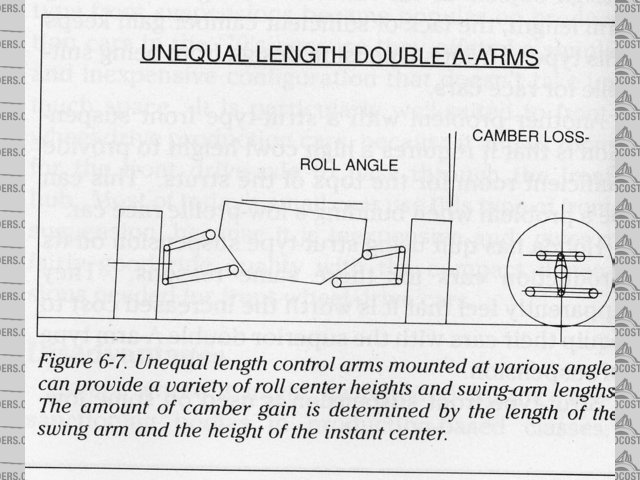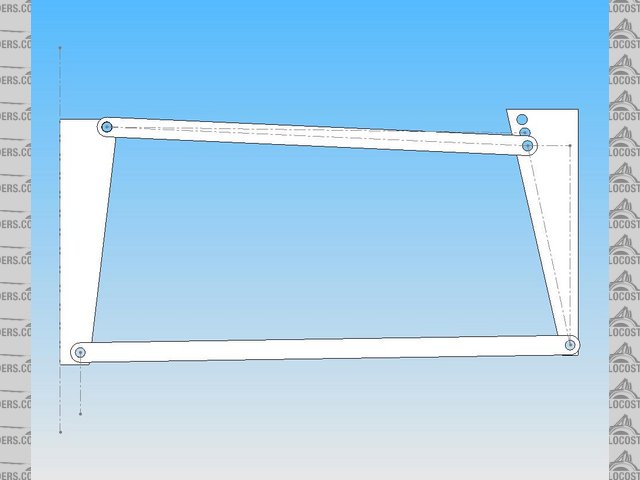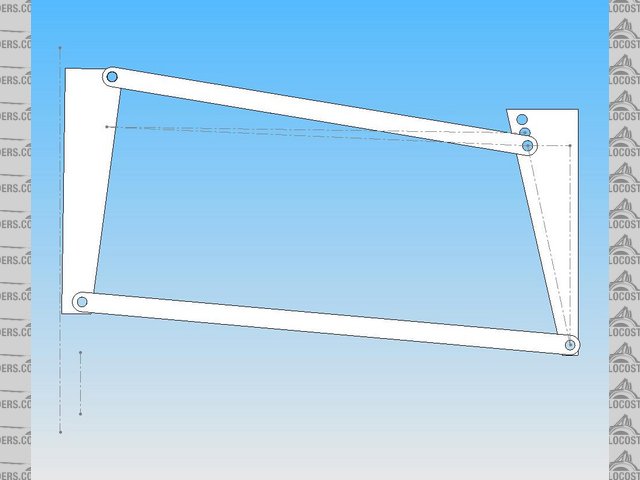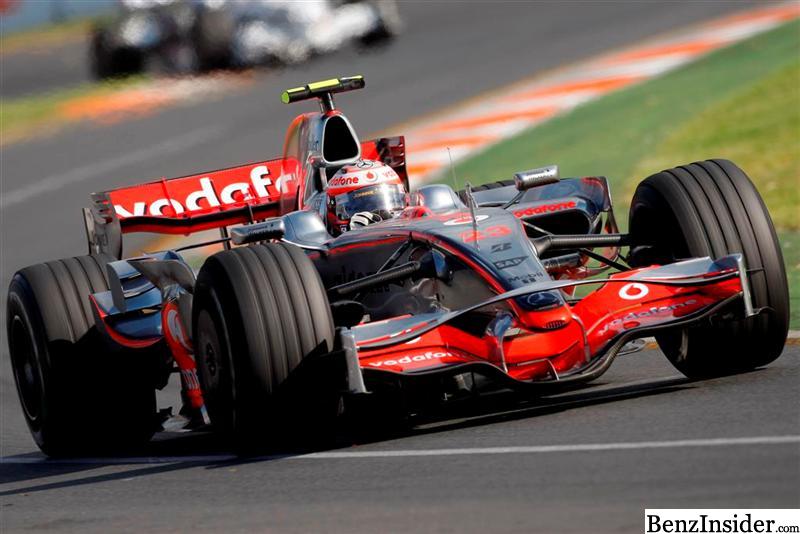garage19
|
| posted on 23/6/08 at 09:28 AM |

|
|
Susp design - camber gain?
In a corner do i want the camber gain from suspension geometry to be:
a)Less on the inside wheel?
b)Less on the outside wheel?
c)The same on both wheels?
Thanks,
Doug.
|
|
|
|
|
nitram38
|
| posted on 23/6/08 at 09:48 AM |

|
|
Doug you need to work out suspension travel in a corner to determine the max camber gain that you want.
Too much can be just as bad as too little.
If you are running a very stiff set up then your camber gain will probably need to be more over a shorter travel.
My MotaLeira has air suspension. It will run at 3" to 6" from the ground so my gain has to be over a longer suspension travel, otherwise I
will wear out my tyres at the 6" height.
Both wheels will have the same suspension arms so one will gain and the other lose.
You need to make models of your suspension arms and pivot them and measure the camber change. You will have to vary the mounting points/length of
arms, until you get what you need.
You can do this with paper and pins or a drawing program.
Here are my trial drawings.
 
unequal wishbones
 
Description
 
up
[img][/img]

|
|
|
rpmagazine
|
| posted on 23/6/08 at 12:33 PM |

|
|
what is the wheel travel and what is the intended use?
Camber gain in roll is a much discussed issue.
www.racemagazine.com.au
|
|
|
Syd Bridge
|
| posted on 23/6/08 at 12:44 PM |

|
|
quote:
Originally posted by rpmagazine
what is the wheel travel and what is the intended use?
Camber gain in roll is a much discussed issue.
......and a much misunderstood and misquoted one as well! Too much BS associated with a very simple piece of geometrical exercise, particularly from
the armchair experts. 
|
|
|
kb58
|
| posted on 23/6/08 at 01:04 PM |

|
|
quote:
Originally posted by Syd Bridge......and a much misunderstood and misquoted one as well! Too much BS associated with a very simple piece
of geometrical exercise, particularly from the armchair experts. 
and I though we were past this, the taking shots while offering no substance... sigh.
Mid-engine Locost - http://www.midlana.com
And the book - http://www.lulu.com/shop/kurt-bilinski/midlana/paperback/product-21330662.html
Kimini - a tube-frame, carbon shell, Honda Prelude VTEC mid-engine Mini: http://www.kimini.com
And its book -
http://www.lulu.com/shop/kurt-bilinski/kimini-how-to-design-and-build-a-mid-engine-sports-car-from-scratch/paperback/product-4858803.html
|
|
|
garage19
|
| posted on 23/6/08 at 02:57 PM |

|
|
quote:
Originally posted by rpmagazine
what is the wheel travel and what is the intended use?
Camber gain in roll is a much discussed issue.
Car is a track/fast road use single seater weighing 450ish kg with 13" wheels running sports tyres eg ACB10 or 888s.
|
|
|
nitram38
|
| posted on 23/6/08 at 05:10 PM |

|
|
quote:
Originally posted by garage19
quote:
Originally posted by rpmagazine
what is the wheel travel and what is the intended use?
Camber gain in roll is a much discussed issue.
Car is a track/fast road use single seater weighing 450ish kg with 13" wheels running sports tyres eg ACB10 or 888s.
I would suspect the camber gain is mimimal as your suspension travel/body roll will be minimal too.
[Edited on 23/6/2008 by nitram38]

|
|
|
Syd Bridge
|
| posted on 23/6/08 at 07:32 PM |

|
|
quote:
Originally posted by kb58
quote:
Originally posted by Syd Bridge......and a much misunderstood and misquoted one as well! Too much BS associated with a very simple piece
of geometrical exercise, particularly from the armchair experts. 
and I though we were past this, the taking shots while offering no substance... sigh.
Now why does that response not surprise me? 
As you sit back in that big comfortable chair, you can rest very much assured that I will NEVER post definitive answers and methods of
my work on any i'net forum, or any public forum for that matter. Just like my peers!
But, some on this forum have benefited from one-to-one already, and will do so ongoing. And to a man, they will not reveal who they are. And for that,
I am eternally grateful. Thanks chaps.
Cheers,
Syd.
|
|
|
nitram38
|
| posted on 23/6/08 at 07:56 PM |

|
|
Eh?
Maybe I am a bit naive here, but I thought this forum was here to help other car builders, not to prove how smug we are.......................
If you aren't part of the solution, you are part of the problem.
(I can't remember who said it, but it's true)

|
|
|
kb58
|
| posted on 24/6/08 at 03:36 AM |

|
|
quote:
Originally posted by Syd Bridge Now why does that response not surprise me? 
Why? Because you've heard it before, on 10/31/07. Since it didn't sink in the last time, here it is again:
quote:
Syd, as I said, I'm all ears - I want to learn - but all I hear is how clueless everyone is. What's with this?:
-"pseudo intellectual discussions"
-"all of you armchair experts"
-"and [what I'm designing] will be travelling quicker than anything you lot will build in your sheds."
Is arrogance the price of knowledge, Syd?
Why allude to being some kind of Suspension Oracle, yet view with distain our attempts at understanding? You won't explain anything, yet insult
our attempts to do so on our own.
Why are you here? I'm disappointed that it's apparently not to educate or enlighten. Answering everything with, "Wow are you guys
wrong", is worse than useless.
Welcome to last year.
[Edited on 6/24/08 by kb58]
Mid-engine Locost - http://www.midlana.com
And the book - http://www.lulu.com/shop/kurt-bilinski/midlana/paperback/product-21330662.html
Kimini - a tube-frame, carbon shell, Honda Prelude VTEC mid-engine Mini: http://www.kimini.com
And its book -
http://www.lulu.com/shop/kurt-bilinski/kimini-how-to-design-and-build-a-mid-engine-sports-car-from-scratch/paperback/product-4858803.html
|
|
|
Syd Bridge
|
| posted on 24/6/08 at 09:00 AM |

|
|
And why is it the same two who want me to put specific details on here? So they can make commercial gain from republishing under their own
titles!!!!
Get used to the idea fellas, ...IT JUST AINT GOING TO HAPPEN!!!!  (Well, at least not without a large amount of money involved. This IS my work you
know.) AS you've also been told on the previous occasion. (Well, at least not without a large amount of money involved. This IS my work you
know.) AS you've also been told on the previous occasion.
Those who I've helped on here, and met me in person, will tell you I'm anything BUT arrogant. I help those who ask politely, and in
confidence. I've also got a pretty good BS sniffer, and have weeded out a few as well!
Cheers,
Syd.
|
|
|
nitram38
|
| posted on 24/6/08 at 09:45 AM |

|
|
quote:
Originally posted by Syd Bridge
And why is it the same two who want me to put specific details on here? So they can make commercial gain from republishing under their own
titles!!!!
Get used to the idea fellas, ...IT JUST AINT GOING TO HAPPEN!!!!  (Well, at least not without a large amount of money involved. This IS my work you
know.) AS you've also been told on the previous occasion. (Well, at least not without a large amount of money involved. This IS my work you
know.) AS you've also been told on the previous occasion.
Those who I've helped on here, and met me in person, will tell you I'm anything BUT arrogant. I help those who ask politely, and in
confidence. I've also got a pretty good BS sniffer, and have weeded out a few as well!
Cheers,
Syd.
Paranoid or What?
As if we are going to go into commercial production of the in's and out's of cambergain!
You can find it in any suspension book, but the idea of a forum is to share knowledge.
It is not as if this knowledge is not already in the public domain.
Syd, I suggest you delete locostbuilders from your shortcuts because you already know everything and have nothing to gain by coming here.
You seem to turn any simple discussion into a war zone.

|
|
|
TheGecko
|
| posted on 24/6/08 at 10:04 AM |

|
|
I have real difficulty seeing what Syd's contribution is here. He only ever pops in to tell us we all know nothing; that he does; and that he
won't discuss it with us without money changing hands. Well, that sounds like an unregistered trader touting for business to me.
Syd, if you've got a helpful contribution to make then do so. If you're just selling your services, then register as a
trader and advertise them. If you're just here for self-aggrandizement, then buzz off!
On the subject (!) of Doug's original question; I don't know if it can be answered as posed. The goal should be to keep the more heavily
loaded outside wheel more vertical. To do that you need to come up with some estimate of how much chassis roll you'll be dealing with in your
chosen corner and how that, projected through your chosen/designed suspension geometry, is going to affect the final camber of each wheel. The simple
solution, of course, is to keep things both light and stiff so that the actual amounts of movement are all relatively small anyway 
What sort of vehicle is this for? [edit] Sorry, missed your second post amongst all the blather. I'd start from the vertical outside wheel and
work back from there. You'll need to know or calculate your roll stiffness to progress things.
Dominic
Disclaimer: I am not a professional suspension engineer nor do I claim to be one. If someone needs advice in my real area of expertise (Oracle
databases and Identity Management/Automated Provisioning systems) I'm happy to offer anything which doesn't breach the Commercial In
Confidence terms my employer expects me to work under (pretty unlikely  ). ).
[Edited on 24/6/2008 by TheGecko]
|
|
|
rpmagazine
|
| posted on 24/6/08 at 10:10 AM |

|
|
Syd you can rest assured that if you ever write anything original or worthy WRT suspension and that I ever print it I will definitely credit you.
Doug, I have recently had many conversations WRT roll and camber gain.
As for your application, you no doubt know there are force based RC's and Geometric RC's. Most of the software packages we can afford use
Geometric RC's and they remain a useful, if admittedly flawed, tool for discussing suspension. Looking at a single axle only, the relationship
between RC and CoG can be summarised (note this is neither a complete description or an accurately described one but it may assist) thus: The distance
between the CoG and RC creates the 'lever' that the roll forces act on and thus the bigger the lever the more 'roll' the car
will likely have at that axle (assuming all other features are the same).
We can mitigate some of these forces by using a sway/anti-roll bar, but we are getting into a more complete discussion and I want to almost stay on
topic!
If we then say "well I'll have them damn close then!" then we run into issues of 'jacking' where instead of rolling the
car will want to lift a wheel.
However it is not just the amount of force but the speed in which the force/roll is reacted. It was suggested to me that I think of RC's as
'fast' reaction and sway bars as 'slow reaction' and advanced dampers somewhere imbetween. This has implications for RC choice
for the type of vehicle (hence my question) and also for the type of control/recovery aspects of a design e.g. if you choose to have high RC's
with a low CoG with your light single seat car you might well get away with it on a track. It is likely that (all other things being equal - AOTBE)
this will mean that your car will be quick to respond to control inputs, but may be too fast at times and is likely to be upset easily by bumps (e.g.
you hit a bump, your hand moves the wheel and your car responds immediately etc).
So what has this got to do with camber gain? Well both not a lot and a bit...you see there is a bit of an interplay - camber gain (really minimising
camber loss) is generally good for steady state cornering and in some cars they add a lot to overcome compliance in the car structure as it flexes
under cornering loads, which is one of the reasons why you see some older racecars such as Escorts with huge amounts of negative static camber on the
front.
The other reason is to keep (mostly) the outside tyre contact patch as uniform as possible with load. In this regard it could be said that we want the
tyre to remain static while the car rolls about it, which is when 'camber gain = roll deg'. not only is this very very hard to predict (it
varies with speed, roll, force etc etc), curiously no manufacturer I discussed this with actually does it! This is partly because negative camber is
only useful when your tyres really need it, which is in high load cornering situations...which for some cars is higher speed (this is where the speed
of roll reaction -CoG/RC etc comes into play) and longer corners. It actually adversely affects longitudinal traction and as such is contraindicated
for braking and start traction. So when you brake heavily and your car dives and you get camber change and then reduced braking effort.
So to too briefly tie the bits together (assume same car and same CoG):
Hillclimbs: you need good longitudinal traction, quick reaction/turn in, minimal roll you could possibly look at higher RC's and less camber
gain.
Sportscar on smooth, high speed track with quick reaction (e.g. exige at Oulton Park): mod RC's and some camber gain...tune camber to keep tyres
happy
Tarmac Rally: Lower RC and possibly less camber gain than above due to road camber changes, need for slower roll reaction and possibly less wheel
camber gain to assist with longitudinal traction - a premium is placed on this due to type of event.
[Edited on 24/6/08 by rpmagazine]
[Edited on 24/6/08 by rpmagazine]
[Edited on 24/6/08 by rpmagazine]
[Edited on 24/6/08 by rpmagazine]
www.racemagazine.com.au
|
|
|
rpmagazine
|
| posted on 24/6/08 at 11:04 AM |

|
|
Note I've just reread the above and it is a bit of a jumbled mess!...I have a bit more of a think on it.
www.racemagazine.com.au
|
|
|
garage19
|
| posted on 24/6/08 at 01:01 PM |

|
|
Thanks for all your input guys.
The chassis should be pretty stiff and suspension movement will be controlled by rod ends rather than rubber/polly bushes so minmal camber gain
required to deal that area.
I guess tyre construction and sidewall strength play a large part in the amount of camber gain required?
Athough i will be using relativly high side wall 13" tyres they will be of the road legal cut slick type eg Toyo 888s so should be pretty stiff
in construction i would imagine?
I have bee playing with an excellent XL spreadsheet for camber change and roll centre location that apparently originated from this forum. Does
anybody know who wrote it?
In my small light car it is currently looking like RC is 1.5 " off the ground with a static ride height of 4". I'm guessing the COG
would be a few inches above that.
Will this make for a un responsive car with slow handling?
|
|
|
pbura
|
| posted on 24/6/08 at 03:31 PM |

|
|
Doug,
There's a nice old free DOS program called Wishbone that is handy for modeling and is available here:
http://www.locostusa.com/forums/viewtopic.php?t=1438
IIRC, Toyo suggests a camber range of 2.5 to 5 degrees for the R888, which is a wide range and will make your job easier. It would seem that 2.5 as a
static camber would be a little hard on the tires, and I'm interested in others' comments on this.
The roll center height will give you some idea how much load will be transferred via the suspension arms rather than the sprung mass. A very high
roll center, say equal to your CG, would not work well because much of the force would be applied laterally against the outside tire, upsetting
traction. A low roll center causes the load to be transferred through the springs, which is better for traction as these push down on the contact
patch. However, to control body roll you will need more spring, possibly interfering with keeping the tire on the ground. Anti-roll bars
shouldn't be used excessively because they are nothing more than undamped springs.
So, it's a balancing act. A strategy employed by many (assuming you have IRS) is to set the rear roll center height at no more than 3"
because above this jacking forces are excessive in an A-arm suspension. The front is usually a bit lower, like your 1.5"; the reasons for this
are somewhat disputed but most agree it helps with initial turn-in. Then, springs are selected for best tire compliance, and any trimming after that
is done with anti-roll bars and shock settings.
In a solid axle car, the roll centers can be higher. A lot of Locost builders are able to avoid anti-roll bars entirely because of this.
Disclaimer: The above was gained through interested though undisciplined self-study of accessible sources such as Allan Staniforth, Carroll Smith,
and Mark Ortiz, and paying attention to various car builders' experiences. Yes, I am an armchair builder. 
[Edited on 24/6/08 by pbura]
Pete
|
|
|
mr henderson
|
| posted on 24/6/08 at 04:26 PM |

|
|
quote:
Originally posted by nitram38
quote:
Originally posted by Syd Bridge
And why is it the same two who want me to put specific details on here? So they can make commercial gain from republishing under their own
titles!!!!
Get used to the idea fellas, ...IT JUST AINT GOING TO HAPPEN!!!!  (Well, at least not without a large amount of money involved. This IS my work you
know.) AS you've also been told on the previous occasion. (Well, at least not without a large amount of money involved. This IS my work you
know.) AS you've also been told on the previous occasion.
Those who I've helped on here, and met me in person, will tell you I'm anything BUT arrogant. I help those who ask politely, and in
confidence. I've also got a pretty good BS sniffer, and have weeded out a few as well!
Cheers,
Syd.
Paranoid or What?
As if we are going to go into commercial production of the in's and out's of cambergain!
You can find it in any suspension book, but the idea of a forum is to share knowledge.
It is not as if this knowledge is not already in the public domain.
Syd, I suggest you delete locostbuilders from your shortcuts because you already know everything and have nothing to gain by coming here.
You seem to turn any simple discussion into a war zone.
As a disinterested observer, I would have to say that that is a very good answer to Mr Bridge's apparent BS
John
|
|
|
Syd Bridge
|
| posted on 24/6/08 at 08:18 PM |

|
|
All I've ever tried to do is get these people to let go that horrid 'Roll centre' stuff, and think for themselves.
Seems they can't let go of the fictional rollcentre theory, and work things out from basic principles.
In cornering, cars don't roll about some mythical centre, they roll about the outer contact patches first, and then on it just gets more
complicated.
If any of you grasped the basic principles, you'd wake up to a whole new outlook.
Call me all the names you like, tell me to F off as much as you like. I'm here, I contribute a lot more useful help than many realise, and will
continue to do so.
I just don't ask for open public adulation or approval or thanks, nor do I sprout regurgitated anecdotal information seeking recognition from
others. Quite the opposite. What I give is given freely, but quietly.
Oh, and as for touting for business, there are more than one or two on here who I've had to refuse to do work for because of my personal
workload. I've only done one small carbon job this year for a very polite gentleman on this forum, and even he ended up waiting three months! So
no, I'm not looking for more work!! I'm actually trying to divest myself of some.
Cheers,
Syd.
|
|
|
Benonymous
|
| posted on 25/6/08 at 01:46 AM |

|
|
F1
I remeber reading in the "Race and Rally Car Source Book" that F1 cars have practically no suspension movement. This would greatly
simplify any suspension geometry calculations wouldn't it?
With no movement in the vertical plane you'd only have to concern yourself with roll and as can be observed on a moving F1 car, they have
none!
It's all in the tyres.......
|
|
|
Doug68
|
| posted on 25/6/08 at 06:18 AM |

|
|
F1 hmm. If only it were that simple... looking at the picture below clearly there's a lot of camber on the front wheels.

But when they're cornering most of the camber has gone, look at the inside front wheel, clearly somethings moved otherwise there wouldn't
be that gap opening up would there?
And if its not roll thats doing it whats going on?

From my point of view the more I learn about this stuff the more I realize how little I know and how much I've left to learn.
Doug. 1TG
Sports Car Builders WA
|
|
|
Delinquent
|
| posted on 25/6/08 at 07:55 AM |

|
|
quote:
But when they're cornering most of the camber has gone, look at the inside front wheel, clearly somethings moved otherwise there
wouldn't be that gap opening up would there?
And if its not roll thats doing it whats going on?
Optical illusion of the camera coupled with tyre distortion giving the car roll (due to weight transfer) around the offside contact patch, the camber
is still there.
The movement of the susp. on modern F1 cars is barely visible to the naked eye, as said they rely almost entirely on the tyre.
[Edited on 25/6/08 by Delinquent]
|
|
|
rpmagazine
|
| posted on 25/6/08 at 09:31 AM |

|
|
quote:
Originally posted by garage19
Thanks for all your input guys.
The chassis should be pretty stiff and suspension movement will be controlled by rod ends rather than rubber/polly bushes so minmal camber gain
required to deal that area.
I guess tyre construction and sidewall strength play a large part in the amount of camber gain required?
Athough i will be using relativly high side wall 13" tyres they will be of the road legal cut slick type eg Toyo 888s so should be pretty stiff
in construction i would imagine?
I have bee playing with an excellent XL spreadsheet for camber change and roll centre location that apparently originated from this forum. Does
anybody know who wrote it?
In my small light car it is currently looking like RC is 1.5 " off the ground with a static ride height of 4". I'm guessing the COG
would be a few inches above that.
Will this make for a un responsive car with slow handling?
Doug at the end of the day it grip is nearly all about making the tyres happy! You will have a relatively light car and so the sidewall stiffness will
be correspondingly high/per unit weight and you may find that you can run quite low pressures - infact may need to to get the tyres warm on a colder
day.
Compliance and chassis stiffness is perhaps less complex. Rod-ends reduce compliance and also simplify suspension design in a way as none of the cheap
software packages can cope with bush compliance. Also try Greg Locock's SLARK program and try the free demo version of susprog...susprog is
really quite good and easy to use.
I fear I may have mislead you a bit: the responsiveness etc is much more complicated than simple RC's but it is a factor. I think that you are
likely to have so much rubber for the weight and low CoG that your car almost cannot help but be responsive!
www.racemagazine.com.au
|
|
|
rpmagazine
|
| posted on 29/6/08 at 02:13 AM |

|
|
quote:
Originally posted by Syd Bridge
All I've ever tried to do is get these people to let go that horrid 'Roll centre' stuff, and think for themselves.
Seems they can't let go of the fictional rollcentre theory, and work things out from basic principles.
In cornering, cars don't roll about some mythical centre, they roll about the outer contact patches first, and then on it just gets more
complicated.
If any of you grasped the basic principles, you'd wake up to a whole new outlook.
I might have some sympathy for this position if I were driving a go-kart
What time frame does the road going vehicle with suspension roll on the outside contact patch?
www.racemagazine.com.au
|
|
|
Syd Bridge
|
| posted on 29/6/08 at 10:31 AM |

|
|
A go-kart is only a car without springs, albeit smaller.
Most things that run with wings today can be interpreted in much the same way.
Check your basic physics and maths, and you should quickly work that out. Maybe??
A simple roll couple of the CoM about the outer contact patch, if you can't work it out yourself.
|
|
|













